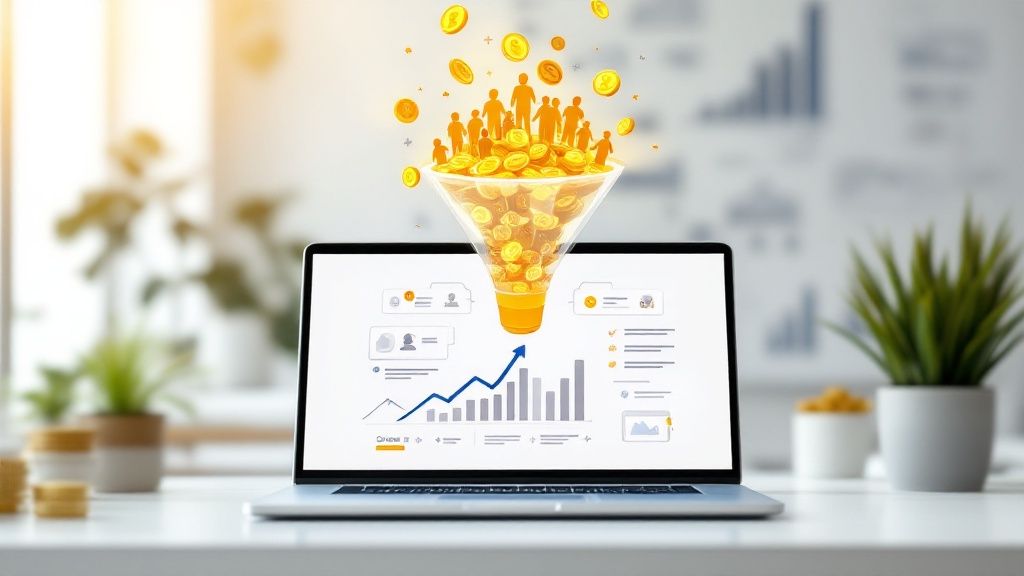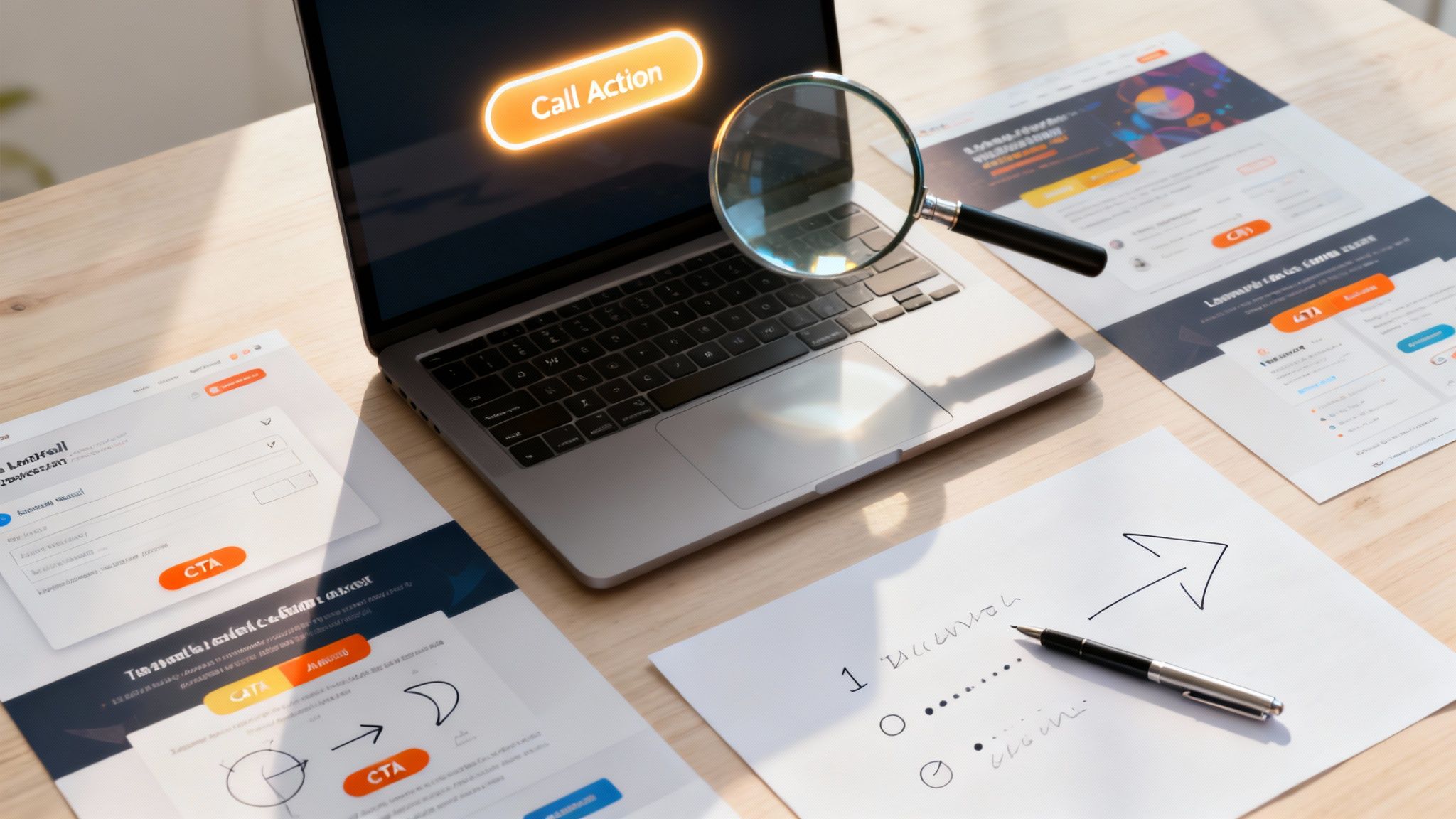
Meta Description: Your complete guide to landing page conversion optimization. Learn a step-by-step framework, from psychology to A/B testing, to turn more visitors into customers.
Struggling to turn website traffic into actual customers? You've poured time and budget into driving people to your site, but most of them arrive, look around, and vanish without a trace. This common pain point means your landing page is leaking money and potential leads every single day. The problem isn't getting more traffic; it's about converting the traffic you already have. This guide offers a practical roadmap for landing page conversion optimization, providing a step-by-step framework to fix those leaks. We'll explore the psychology of a high-converting page and give you a repeatable process to transform your page from a leaking bucket into a powerful conversion machine.
The Psychology of a High-Converting Page

What convinces a visitor to click, sign up, or buy? It's rarely about flashy design; it's about human psychology. A high-converting page is a well-scripted conversation that builds trust, provides clarity, and guides users toward a confident "yes." The moment someone lands on your page, they're silently asking: "Am I in the right place?", "What's in it for me?", and "Can I trust this?" Effective landing page conversion optimization is about answering those questions instantly. A great starting point for understanding your audience's mindset is learning how to conduct competitor analysis to see what messaging resonates in your space.
The Power of Message Match
One of the most crucial principles is message match. The ad, email, or social post that brought the visitor to your page made a specific promise. Your landing page must instantly deliver on it. If someone clicks an ad for "50% Off Running Shoes" but lands on a generic homepage, the match is broken. This disconnect creates confusion and friction, making them hit the back button. A strong message match reassures visitors they've landed in the right spot, which immediately builds trust. This simple alignment between your ad and your landing page is often the single biggest lever you can pull.
Crafting a Single, Compelling Call to Action
Confusion is the ultimate conversion killer. Your landing page should have one main goal, which means it needs one primary call-to-action (CTA). This singular focus eliminates decision fatigue. Do you want them to "Book a Demo" or "Download the Guide"? Pick one, and build the entire page to support that single action.
- Make it visible: Use a color that contrasts with the rest of the page.
- Use action-oriented text: Ditch "Submit." Try "Get My Free Guide."
- Place it strategically: Position it where a user's eyes land after reading your value proposition.
This focused approach creates a clear path for the user to follow. You can dig deeper into the intersection of advertising and psychology to master this.
Building Instant Credibility and Trust
Before anyone converts, they have to believe you. Trust is built through social proof, clarity, and showing your value. Focus on benefits, not just features. Instead of listing technical specs, tell them how your product will solve their problem. Then, back it up with trust signals.
- Testimonials and reviews: Real words from happy customers are pure gold.
- Logos of well-known clients: If you work with big names, show them off.
- Data and statistics: A specific number, like "98% customer satisfaction," feels more concrete and believable than a vague claim.
These elements lower skepticism and build the confidence a visitor needs to take the next step.
Measuring What Matters for Optimization Success

You can't improve what you don't measure. This is especially true for landing page conversion optimization. Flying blind and hoping for better results is a recipe for wasted time and money. Real growth comes from understanding the story your data is telling you. While it’s tempting to obsess over the final conversion rate, that single metric doesn't give you the full picture. It tells you what happened, but not why. To diagnose problems, you need to look at other key performance indicators (KPIs). Think of these metrics as your diagnostic toolkit. They reveal how people interact with your page, turning vague guesses into actionable insights.
Key Landing Page Performance Metrics
To get a complete view of your landing page's health, track a few core metrics. Each reveals a different piece of the user's journey, helping you build a clear hypothesis for your next A/B test. This is especially critical when optimizing ad conversions from different campaigns, as each has a unique audience and intent.
| Metric | Definition | Why It Matters for CRO |
|---|---|---|
| Conversion Rate | The percentage of visitors who complete the desired action (e.g., sign up, purchase). | Your ultimate success metric. All optimization efforts are aimed at lifting this number. |
| Bounce Rate | The percentage of visitors who leave after viewing only one page. | Signals that your page isn't meeting visitor expectations, possibly due to poor design or a weak message. |
| Average Time on Page | The average amount of time visitors spend on your page before leaving. | Indicates engagement. If people aren't sticking around long enough to read your offer, they'll never convert. |
| CTA Click-Through Rate (CTR) | The percentage of visitors who click your main call-to-action button. | A low CTR can mean your CTA copy, design, or placement is weak, even if the page is engaging. |
By looking at these numbers together, you can connect the dots. For a deeper dive into analytics, check out our guide on how to measure content performance.
Your Step-By-Step Optimization Framework

Successful landing page conversion optimization isn’t about guesswork; it’s a methodical, repeatable process. This framework breaks the cycle into four clear, actionable stages. Think of it as your blueprint for engineering conversions on purpose.
Stage 1: Conduct Thorough Research
Before making any changes, you must understand what’s happening right now. This stage is about gathering the "what" and the "why" behind your users' behavior. Your job here is to be a detective, looking for clues—areas of friction, moments of confusion, or anything that makes a visitor hesitate.
- Heatmaps: Show you where people click, how they move their mouse, and where they stop scrolling.
- Session Recordings: Watch anonymous recordings of real people navigating your page to see exactly where they get stuck or frustrated.
- User Surveys: An exit-intent survey asking, "What stopped you from signing up today?" can uncover roadblocks you'd never have guessed.
Stage 2: Form a Strong Hypothesis
Once you've done your homework, it's time to make an educated guess. A hypothesis is a clear, testable statement that predicts an outcome. It follows a simple formula: "If we [make this specific change], then [this specific outcome will occur], because [this is the data-driven reason]." For example: "If we change the headline to focus on the 'free trial' benefit, then we will see a 15% increase in sign-ups, because user feedback showed confusion about the cost." This structure forces you to tie every idea back to your research.
Stage 3: A/B Test Your Ideas
Now, put your hypothesis to the test. A/B testing is where you pit two versions of a page against each other—the original "control" and the new "variation"—to see which one performs better. By changing only one thing at a time, you can measure its direct impact on conversions. Let tests run long enough to collect enough data for a statistically significant result. To keep your process on track, follow a comprehensive conversion rate optimization checklist.

Stage 4: Analyze and Iterate
Once your test is done, analyze the results. If the variation wins, great! Roll it out and ask why it won. If the control wins, it's not a failure; it’s a lesson about what your audience doesn't respond to. No matter the outcome, the insights from one test feed directly into the research for the next one. This creates a powerful loop of continuous improvement, which is the heart of successful optimization.
👉 Try MediaWorkbench.ai for free – schedule your posts and generate AI content in one place!
Proven Tactics That Boost Landing Page Conversions
Knowing the theory is great, but real magic happens when you have a toolbox of proven tactics. The best landing page conversion optimization is about making a series of small, psychologically-driven tweaks that snowball into huge wins. Here are powerful strategies you can test today.
Craft Irresistible Headlines and Subheadings
Your headline has about three seconds to convince a visitor they’re in the right place. A great headline is clear, short, and screams value. It must immediately answer your visitor's unspoken question: "What’s in it for me?" Clarity always trumps cleverness. Use subheadings to back up your big promise and break down key benefits into scannable points. If you're new to this, diving into foundational copywriting tips for beginners can help you write words that connect.
Leverage Social Proof and Testimonials
People trust other people far more than they trust brands. Social proof is a powerful psychological shortcut.
- Customer Testimonials: Use real quotes from happy customers. Add a name, company, and photo to make them genuine.
- Client Logos: If you’ve worked with well-known companies, show off their logos for instant credibility.
- Case Studies: A quick summary of a success story with hard numbers (e.g., "Helped them increase leads by 78%") is incredibly persuasive.
- Data and Numbers: Specifics like "Trusted by over 50,000 marketers" build confidence.
Prioritize Page Speed and Mobile Responsiveness
We live in an age of zero patience. Speed isn't a feature; it's a requirement. The effect of page load time on landing page conversion optimization is staggering. A page loading in one second can see triple the conversion rates of one that takes five seconds. As stats from WordStream on the importance of page speed show, every millisecond counts. And with most traffic coming from mobile, a responsive design is non-negotiable. That means big, tappable buttons, readable text, and a clean, single-column layout.
Time to Start Your Optimization Journey
Landing page conversion optimization is not a one-and-done task; it’s a continuous loop of learning, testing, and improving. Committing to this cycle is how you build a real engine for growth. We’ve walked through the fundamentals, from nailing down clarity and building trust to measuring what matters. You now have a solid, step-by-step framework for digging into research, forming smart hypotheses, and launching tests that move the needle. The only thing left is to put it into practice. As you get started, remember that your A/B test ideas are only as good as the creative you use to execute them. This is where having the right creative tools like MediaWorkbench.ai can make all the difference, fueling your optimization efforts with high-quality content.
Ready to create compelling copy and visuals for your A/B tests? Media Workbench AI provides the on-demand content generation tools you need to bring your optimization ideas to life quickly. Explore our features and start building higher-converting pages today.

